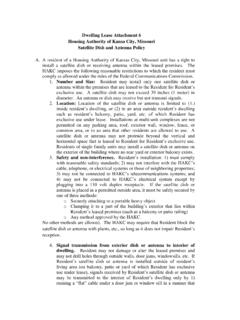Transcription of VPN over Satellite - VSAT Systems
1 Page 1 of 5 VPN over Satellite A comparison of approaches by Richard McKinney and Russell Lambert As awareness of Satellite Internet access becomes more wide spread, demand for secure connections from remote locations to corporate local area networks continues to increase. The high latency inherent in geosynchronous Satellite connections has presented a significant obstacle to efficient virtual private network (VPN) connections over Satellite . Various solutions to carrying IP traffic over Satellite have been proposed, but each one has had some limitation that prevented it from becoming widely adopted. Recently Encore Networks released their VSR-30 3 DES VPN device which offers the most popular features of IPSEC appliances, but leaves the IP header unencrypted. This feature makes the VSR-30 attractive for Satellite -based VPN applications because visible headers allow Satellite operators to optimize throughput.
2 The Problem In order for a two-way Satellite service to perform properly in conjunction with traditional terrestrial networks (Internet, Intranet), Satellite data networks must employ special techniques to deal with the extra 44,600-mile space segment of the connection. Without those steps, the increased latency, the time required to traverse the extra distance, means that TCP severely limits performance. The Internet relies on the Transmission Control Protocol (TCP) to ensure packet delivery without errors. TCP works by sending a certain amount of data, the window size, then waiting for the receiver to send an acknowledgment of receipt. With TCP, the sender cannot transmit more data until it has received an acknowledgment. If an acknowledgment does not arrive in a timely manner, TCP assumes the packet was lost (discarded due to network congestion) and resends it.
3 When packets go unacknowledged, TCP also slows the transmission rate to reduce congestion and to minimize the need for retransmissions. TCP/IP sessions start out sending data slowly. Speed builds as the rate of the acknowledgments verifies the network s capacity to carry more traffic. This is known as slow-start, followed by a ramp-up in speed. The speed of the connection builds until the sender detects packet loss from a lack of an acknowledgment. This allows TCP to achieve the fastest practical data transfer rate for the conditions present on the network. Terrestrial networks typically have round-trip latencies in the range of 35 to 100 ms. Satellite networks, due to the distance of geosynchronous satellites above the equator, require 550 ms or more. Some Satellite connections have much higher latencies. Depending upon the Satellite hardware and subscription policy of the service provider, latencies of 800 ms to as much at 2,000 ms or more can occur.
4 TCP interprets the additional Satellite transit time as network congestion. If uncorrected, this effect causes the network to send all additional packets at the slow-start rate. Current Satellite data networks employ a technique referred to as TCP acceleration or IP spoofing to compensate for the extra time required to transit the space segment. Special equipment at the carrier s main Satellite hub appears to terminate the TCP session, so it appears to the sender as the remote location. In actuality the device at the Satellite hub acts as a relay or forwarder between the originating terrestrial location and the remote Satellite unit. When the spoofing equipment receives Internet traffic destined for a remote Satellite location, it immediately acknowledges receipt of the packet to the sender so more data packets will follow promptly.
5 This way the sender never experiences the actual latency to the remote site because acknowledgments return rapidly. As a result, TCP moves out of slow-start mode quickly and builds to the highest practical speed. To prevent packets from being acknowledged twice, the spoofing equipment suppresses acknowledgments from the remote site. In this way, computers behind a Satellite link communicate seamlessly and efficiently with servers on the terrestrial Internet. IPsec VPNs not only encrypt the data portion of packets, they also encrypt the TCP port number and IP address of the sender s computer. (Think of TCP port as the apartment number while the IP address is that of the Sales & Engineering 3500 Virginia Beach Blvd Virginia Beach, VA 23452 Ground Operations 1520 S. Arlington RoadAkron, OH 44306 Page 2 of 5 building.) Consequently, only the VPN software at the remote site can decipher where packets originated and acknowledge receipt of data.
6 Popular IPsec VPNs, therefore, defeat TCP acceleration over Satellite links because ground stations cannot adjust the fields in the header when those fields are encrypted. This situation requires that acknowledgments transit the space segment twice ( over and back) and results in substantial performance degradation. The impact on performance increases as the latency rises. To determine the effect of latency on performance and to measure the effectiveness of an alternative VPN device, engineers at Skycasters transferred a variety of data files over a high-quality Satellite link under controlled conditions and measured the results. Test Procedure The test compared transfer rates over a Cisco 1711 IPsec VPN and an Encore VSR-30 Selective Layer Encryption (SLE) appliance to each other and to the speed of file transfers over the open Internet (unencrypted).
7 The data moved from remote to server, then from server to remote using FTP. Transfer rates were measured in kilobits per second (Kbps). The test utilized six different files to measure data transfers rates: 500 kilobyte, 5 megabyte, and 10 megabyte files in both compressible (text) and non-compressible (binary) forms. Both the Cisco and Encore equipment used 3 DES encryption. However, the Encore unit s SLE encrypted only the data, leaving the IP and TCP headers accessible. With the headers accessible, the encrypted packets are compatible with all types of Satellite modems and all methods of TCP acceleration. The test transferred files between two similarly configured FreeBSD computers containing three identical network cards. With three cards in each system, the computers could multi-home and physically separate data.
8 The resulting three data paths facilitated the near simultaneous testing of the two VPN circuits and the unencrypted, clear connection. The remote connection utilized an iDirect NetModem II commissioned for 512 Kbps/512 Kbps service to the Internet. The host side had a cable modem connection running at 3 Mbps/384 Kbps. The 384 Kbps outbound connection limited the ability to test the full 512 Kbps download capability of the Satellite modem, but it did provide adequate results to compare relative speeds of encrypted and unencrypted data coming from the host. The latency of the Satellite link used in these tests Page 3 of 5 ranged from approximately 550 ms to 625 ms. (Some Satellite connections have much higher latencies. Depending upon the Satellite hardware and subscription policy of the service provider, latencies of 800 ms to as much at 2,000 ms have been observed.)
9 The performance of any shared bandwidth system varies throughout the day. To minimize bandwidth effects on results, five iterations of each test ran at different times. To further reduce the influence of bandwidth fluctuations, the testing sequence progressed through all six files, once in each direction, before repeating the transfer of any one file. For example, the 500 K text file ran through the SLE tunnel, then the IPsec circuit, and finally in the clear. Next a 500 K binary file passed through each circuit, and so on. Each interleaved sequence of transfers repeated five times. An efficient VPN solution must do more than simply transfer files proficiently. The time to establish a TCP/IP session can significantly impact how applications run across a high-latency connection. To gain an indication of the rate at which the connections could establish TCP/IP sessions, the test procedure transferred a directory file and a group of web pages back and forth.
10 The time required to establish a TCP/IP session can have a noticeable impact on the performance of some web-enabled applications. Since each file included in a web page requires the browser to start a new HTTP connection to the server, a page with multiple graphics, framed text, or media in external files will cause a delay as multiple connections open and close. Similar circumstances occur in FTP connections as a client traverses the server s file structure if that action involves multiple files. To illustrate TCP/IP session initiation efficiency, the test protocol included two additional procedures. First, each server transferred a directory containing files of different sizes and composition over and back across the connections using FTP. Second, the servers moved a series of web pages to and from the remote site using HTTP.








